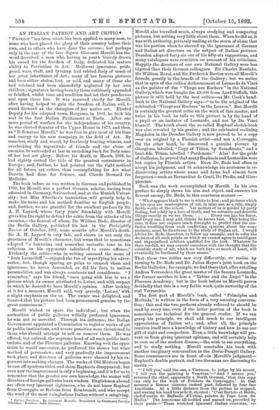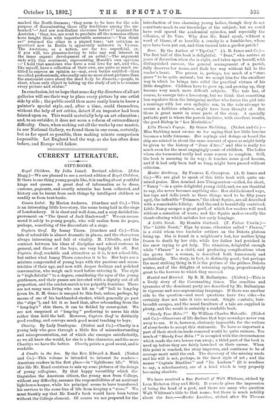AN ITALIAN PATRIOT AND ART CRITIC.•
"PATRIOT "13 a term which has been applied to many men, to some who have placed the glory of their country before their own, and to others who have done the reverse ; but perhaps only in the case of the late Signor Giovanni Morelli has the word described a man who, having in youth bravely drawn his sword for the freedom of Italy, dedicated his mature ability to Patriotism in Art. Medieval ignorance, pride, greed, wars, theft, and tyranny, had robbed Italy of much of her great inheritance of Art ; many of her famous pictures had been either stolen, lost, or sold, and many of those she had retained had been shamefully neglected by her own children ; signatures having been by them ruthlessly appended or falsified, whilst time and tradition had set their ponderous seal upon these lies. It was reserved chiefly for Morelli, after having helped to gain the freedom of Italian soil, to stand forward as the champion of her native art. Elected Deputy for his adopted town, Bergamo, in 1861, he took his seat in the first Italian Parliament at Turin. After one more period of warfare for the independence of his country, he was elected Senator of the Upper House in 1873, and then, as " Il Senatore Morelli," he was free to give most of his time and energy to his new campaign in the field of Art. By ceaseless study and travel, by fearlessly bearing witness, and overlooking the ingratitude of friends and the abuse of enemies, he succeeded at last in snatching back for Italy some of her lost art glory. Before his death, in March, 1891, he had rightly earned the title of the greatest connoisseur in Europe ; and, further, he had pointed out the right method for all future art critics, thus accomplishing for Art what Darwin had done for Science, and Claude Bernard for Medicine.
The book before us was written in German and published in 1890, for Morelli was a perfect German scholar, having been educated in Germany, Switzerland, and at the Munich Univer- sity; but Miss Ffoulkes's translation will greatly help to make his name and his method familiar to English people ; and, further, we are grateful for the excellent preface by Si A. H. Layard, whose forty years' friendship with Morelli gives him the right to defend the critic from the attacks of his enemies,—the fiercest of whom, Dr. William Bode, director of the Berlin Gallery, published his last in the Fortnightly Review of October, 1891, some months after Morelli's death. Sir A. H. Layard is very fair, and shows us not only the greatness of Morelli's character, but owns that he sometimes adopted " a bantering and somewhat sarcastic tone in his criticism on his opponents calculated to cause offence." Evidently the critic—who in writing assumed the name of " Ivan Lermolieff "—enjoyed the fun of mystifying his adver- saries; but, though sparing no pains to unmask sham and ignorance, he never descended, as did his foes, to useless personalities, and was always courteous and considerate. " I remember," says his friend, " once going with him to see a picture which its owner attributed to Luino, and with respect to which he desired to have Morelli's opinion. After looking at it for a moment, Morelli said, very gravely, Ltd-no,' with a slight emphasis on the no. The owner was delighted, and boasted that his picture had been pronounced genuine by the great connoisseur."
Morelli wished to spare the individual ; but when the authorities of public galleries wilfully preferred ignorance, he was not so merciful. Through his influence, the Italian Government appointed a Commission to register works of art in public institutions, and severe penalties were threatened to those who should attempt to sell or remove them. He was offered, but refused, the supreme head of all such public insti- tutions, and of the Florence galleries. Knowing well the oppo- sition he would encounter, he preferred the slower but wiser method of persuasion ; and very gradually the improvement took place, and directors of galleries were shamed by his ex- posures into making changes. The works of Old Masters began to cast off spurious titles, and sham Raphaels disappeared ; but even now the improvement is only a beginning, and it is for us to remember that the greater our own knowledge, the sooner will directors of foreign galleries learn wisdom. Englishmen abroad are often very ignorant sightseers, who do not know Raphael from Correggio, or Rubens from Rembrandt, and who accept the word of the most vainglorious Italian without a misgiving.
• Italian Painters. By Giovanni Morelli. Translated by Constance Jocelyn Ficadkes. London: John Murray.
Morelli also travelled much, always studying and comparing pictures, but writing very little about them. When he did so, it was with authority, privately smiling at the storm of abuse that was his portion when he showed up the ignorance of German and Italian art directors on the subject of Italian pictures. Dresden adopted forty-six out of his fifty-six suggestions, and many catalogues were rewritten on account of his criticisms. Happily the directors of our own National Gallery were less bigoted than their German colleagues. Sir Charles Eastlake, Sir William Boxal, and Sir Frederick Burton were all Morelli's friends, greatly to the benefit of the Gallery; but we notice that in spite of the critics' dethronement of Leonardo da Vinci as the painter of the " Vierge aux Rochers " in the National Gallery, which was bought for £9,000 from Lord Suffolk, this picture is still held by the best critics—as Mr. Cook's hand- book to the National Gallery says—" to be the original of the celebrated Vierge aux Rochers ' in the Louvre." But Morelli is certainly the greatest critic on the work of this master, and twice in his book he tells us this picture is by the hand of a pupil or an imitator of Leonardo, and not by Da Vinci himself. The truth about the so-called Raphael sketch-book was also revealed by his genius ; and the celebrated reclining Magdalen in the Dresden Gallery is now proved to be a copy —or an original by a Flemish artist—and not a Correggio, On the other hand, he discovered a genuine picture by Giorgione, labelled, " Copy of Titian, by Sassoferato," and a, bonil-fide Titian, labelled " Pordenone." Alas ! for the pride of Galleries, he proved that many Ra phaels and Leonardos were but copies by Flemish artists. Even Dr. Bode had often to accept his judgment, and to acknowledge his acuteness in re- discovering artists whose name and fame had almost been forgotten—such as Bernardine de Conti, De Predis, and Gian- pietrino.
Such was the work accomplished by Morelli. In his own preface he simply shows his aim and object, and answers his fiercest enemy, Dr. Bode, in this courteous manner :—
" What appears black to me is white to him ; and pictures which in his eyes are masterpieces of art, in mine are, as a rule, simply feeble works of the school. Yet neither of us is guided by party feeling, but solely by a love of truth, and we estimate and describe
things exactly as we see them Every one has his fancy, and every one, I may add, thinks he knows best. This being the case, it does not require much foresight to predict that the con- fusion resulting from such conflicting opinions about the same pictures, must be disastrous to the study of Italian art. I would advise Dr. Bode, therefore, to follow my example, and to refer the decision of all such points on which we cannot agree to intelligent and unprejudiced arbiters qualified for the task. Whatever be their verdict, we may console ourselves with the thought that the scientific study of art, which we both have so much at heart, will eventually be furthered by these means."
That these two critics saw very differently, we realise by turning to Dr. Bode and Dr. Julius Meyer's joint book on the Berlin Galleries ; for example, we find there that, after extolling
Andrea Verrocchio, the great master of the famous Leonardo, the former ascribes to him a "Tobias and the Angel" in the Florence Academy ; but in the book before us Morelli proves decidedly that this is a very feeble work, quite unworthy of the real Verrocchio.
The first part of Morelli's book, called " Principles and Methods," is written in the form of a very amusing conversa- tion; this and the two prefaces already referred to should be read by every one, even if the latter portion of the book is somewhat too technical for the general reader. If we can grasp his principle, we shall add much to our intelligent appreciation of Italian art ; and, after all, the principle resolves itself into a knowledge of history and how to use our gift of sight and comparison. Even a little knowledge will pre- vent ns from giving ignorant opinions, and will certainly help to cure us of the modern disease,—the wish to see everything, and to study nothing. Morelli concludes his book with another imaginary conversation in the Doria-Pampli Gallery.
Some connoisseurs are in front of—in Morelli's judgment- Raphael's double portrait, and two Germans are discussing its merits :—
"' I tell you,' said the one, a Viennese, to judge by his accent, I tell you the painting is Venetian.'—`And I assure you,' returned the other, apparently a North German, `that this copy can only be the work of Polidoro da Caravaggio.' At that moment a Roman cicerone rushed past, followed by four fair Americans. At a little distance from the picture he stopped, and waving his hand towards it, shouted : C'est Bartolo et Baldo, chef-d'ceuvre de Raffaello d'Urbini, peintre de Pape Leon dei Medici.' The Americans all nodded and passed on, preceded by their guide. = These wretched ignorant Italian cicerones,' re-
marked the North German; they seem to be here for the sole purpose of disseminating these silly traditions among the un- learned.'—' And are non-Italian cicerones better ?' inquired the Austrian ; they, too, are wont to proclaim all the nonsense others have taught them with imperturbable assurance.'—' You think so ?' returned the other in a piqued tone ; art criticism as practised now in Berlin is apparently unknown in Vienna. The Austrians, as a nation, are far too superficial, or, if you will, too pleasure-loving to take any real interest in the inner organic development of an artist.'—The argument ends with this sentiment, representing Morelli's own opinions —` I hold that amateurs who have a real love for art, and who, like myself, have a collection of their own, are quite as much en- titled to express all opinion as—nay, even better entitled—than so-called professionals, who really care no more about pictures than the anatomist cares about the dead body he dissects,—people, in short, whose only object in taking up the study of art is to rename every picture and statue."
In conclusion, let us hope that some day the directors of all art galleries will see their way to place every picture by one artist side by side ; the public could then more easily learn to know a painter's special style, and, after a time, could themselves, without the help of art critics, detect if an imposter had been foisted upon us. This would materially help an art education ; and, to an outsider, it does not seem a reform of extraordinary difficulty. Once, when seeking out all the works by one master, in our National Gallery, we found them in one room, certainly, but as far apart as possible, thus making minute comparison impossible. Let England lead the way, as she has often done before, and Europe will follow.



































 Previous page
Previous page